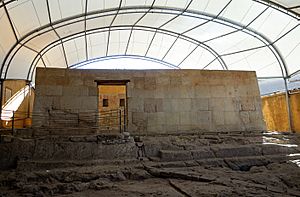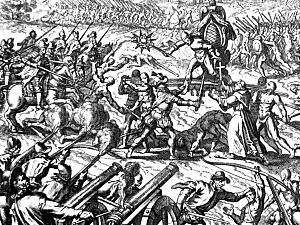Ransom Room facts for kids
The Ransom Room (which means El Cuarto del Rescate in Spanish) is a small building in Cajamarca, Peru. It is famous because it's believed to be where the Inca Empire ended. This happened when the Inca Emperor Atahualpa was captured and later executed there.
Atahualpa's Capture (1532)
On November 15, 1532, a Spanish explorer named Francisco Pizarro arrived in Cajamarca. He sent a message to Atahualpa, the Inca Emperor, inviting him to meet in the main town square.
The next day, on November 16, 1532, a friar named Vincente de Valverde met Atahualpa. He used an interpreter, Felipillo, to explain the Christian religion. The friar told Atahualpa that the Pope had given his kingdom to the Spanish.
Atahualpa did not understand this. He refused to give up his kingdom, saying he would not be "anyone's servant." The friar then gave Atahualpa a Bible. Atahualpa looked at it, turned a few pages, and then threw the book on the floor.
Atahualpa then asked why the Spanish were in his land. At this moment, Pizarro and his soldiers attacked. They rode out on horses and used firearms. Many of Atahualpa's soldiers ran away when they heard the loud sounds of the guns.
Many native people died trying to fight the better-armed Spanish. Pizarro then found Atahualpa, who was protected by his loyal nobles. In the end, Atahualpa and his nobles were captured by the Spanish.
During this time, Atahualpa ordered his half-brother, Huáscar, to be killed. Atahualpa believed Huáscar was a problem for him ruling the empire. He did this to stop Pizarro from deciding who should be the true Inca ruler.
Atahualpa's Trial and Execution (1533)
After the battle, Atahualpa offered Pizarro a deal to gain his freedom. He promised to fill the room where he was held with gold. He also offered to fill two other rooms with silver. He said he would fill them as high as he could reach.
The room was about 6.70 meters (22 feet) long and 5.18 meters (17 feet) wide. The line marking the height of Atahualpa's reach was 2.75 meters (9 feet) high. Atahualpa asked for two months to gather all this treasure.
The total amount of gold collected was huge. After being melted down, it was worth a lot of money. In today's money, it would be nearly half a billion dollars. There was also a large amount of silver. Some beautiful items were saved for the Spanish king. These included vases, plant and animal figures, and even a fountain.
Atahualpa then demanded to be set free, as promised. However, Diego de Almagro, another Spanish leader, wanted Atahualpa to die. He thought it was necessary for peace and for the Spanish crown. Pizarro and Hernando de Soto were not so sure.
Finally, Pizarro agreed to a trial. He and Almagro acted as judges. Atahualpa was found guilty and sentenced to be executed that night. Friar Valverde signed the judgment, agreeing that Atahualpa deserved death.
Atahualpa spoke to Pizarro, asking why he and his children faced such a fate. He reminded Pizarro of the friendship and kindness he had shown the Spanish.
Two hours after sunset on August 29, 1533, Atahualpa was ready for his execution. Friar Valverde offered him a different way to die if he agreed to be baptized. Atahualpa agreed and was baptized, taking the name Francisco Atahualpa. This was in honor of Francisco Pizarro. His last wishes were for his body to be taken to Quito and for Pizarro to be kind to his children.
After Atahualpa was executed, the "Tahuantinsuyo" (Inca Empire) soon came to an end. This marked the start of the Spanish conquest of Peru.
See also
 In Spanish: Cuarto del Rescate para niños
In Spanish: Cuarto del Rescate para niños



